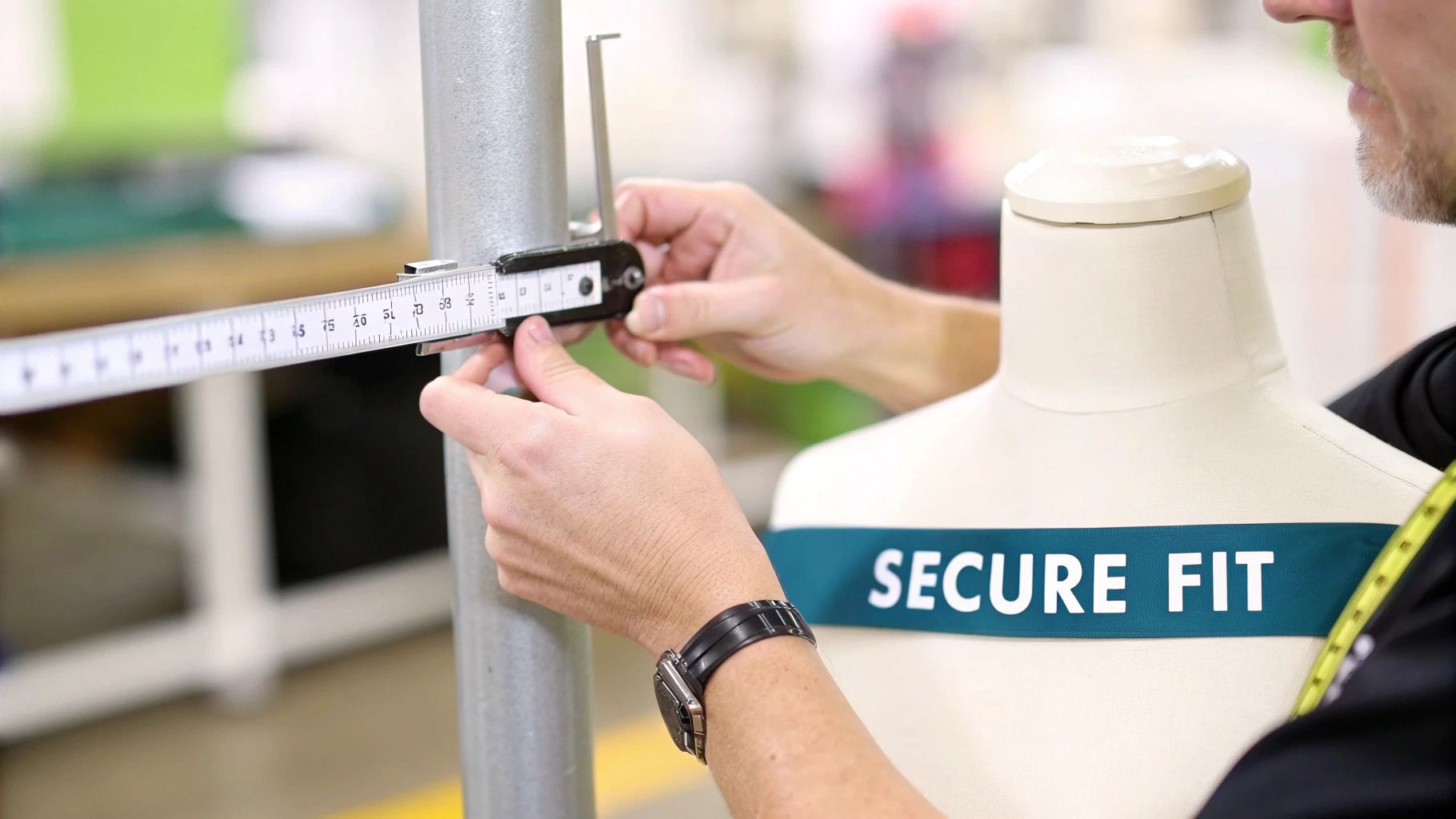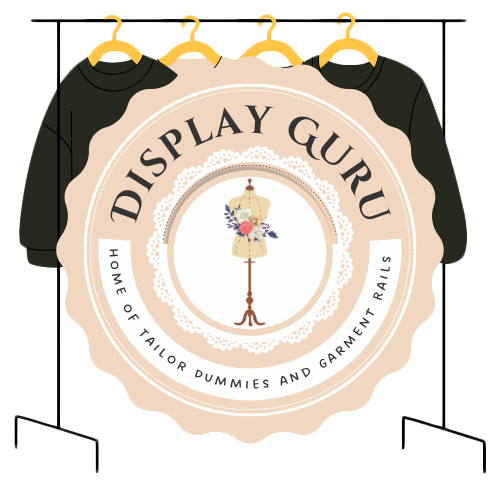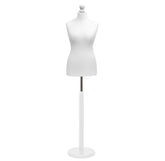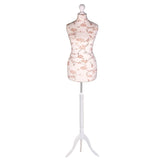Choosing the Right stand for mannequin
A good stand for a mannequin is more than just a bit of metal holding up a body form. Think of it as the unsung hero of your display—the foundation that provides stability, enhances the presentation, and ultimately defines the entire look. Without a solid, well-chosen stand, even the most beautifully styled mannequin is just a disaster waiting to happen.
The Foundation of Every Great Display
The right stand for your mannequin has two crucial jobs. First, and most obviously, it’s a practical tool that stops your display from toppling over in a busy shop—a costly and embarrassing accident. Second, it’s a design element in its own right, subtly influencing how a garment hangs and how customers perceive the quality of your brand. It’s the silent partner in every successful display.
It’s a bit like the chassis of a car. Everyone admires the sleek bodywork, but it’s the frame underneath that dictates performance, safety, and structural integrity. In the same way, a wobbly or mismatched stand sends a message of carelessness, undermining the quality of the clothes you're trying to sell. To get the wider picture on how props work together, this guide on how to choose props for effective display offers some brilliant advice on telling a cohesive story.
The Core Concepts of Stability
Getting to grips with the relationship between the stand's base and the mannequin is the first step to creating a display you can trust. This isn't just about preventing a slight wobble; it's about building a secure setup that protects your valuable stock and keeps your customers safe.
Several key elements work together to create a stable display:
- Base Weight: It's simple physics. Heavier bases, usually made from cast iron or thick steel, create a lower centre of gravity. This makes the entire unit much harder to knock over, which is absolutely essential for full-body mannequins or when you’re displaying heavy pieces like wedding gowns or winter coats.
- Base Shape and Footprint: A wider base spreads the weight over a larger surface area, increasing stability. You'll find square, round, and tripod bases, and each offers a slightly different profile that works better on certain floor types or in different retail layouts.
- Secure Connection: The point where the pole attaches to the mannequin, whether it's a calf rod or a foot spike, needs to be completely secure. A loose connection here is the number one cause of an unstable, leaning mannequin.
It's worth remembering that a mannequin is not a dress form. While both give you a body shape to work with, a mannequin stand is engineered specifically for display stability, while a dress form stand is designed for the hands-on practicalities of sewing and fitting.
Beyond Stability: Presentation Matters
Don't forget that the stand is also a key part of the visual story you're telling. A simple, minimalist chrome stand adds to a modern, clean aesthetic, whereas an ornate wooden stand might be the perfect complement for a vintage or boutique collection. Your choice quietly reinforces your brand identity.
Taking the time to understand the different display stands for clothing is the best way to make a choice that supports both the safety and the style of your shop. This is the foundational knowledge you’ll need to pick the perfect stand for your specific requirements.
Comparing the Different Types of Mannequin Stands
Picking the right stand for your mannequin can feel daunting, but it’s much simpler once you get to know the main players. Each type is built for a specific job, striking a different balance between mobility, stability, and style. The stand you choose will fundamentally shape how your displays work—and look—in your space.
Think of it like choosing tyres for a car. You wouldn't put slick racing tyres on a 4x4 for an off-road adventure, and rugged, chunky tyres would be a nightmare on a smooth racetrack. It’s the same with mannequin stands. A bustling shop floor has completely different needs to a quiet photography studio.
This simple hierarchy shows how the foundation (the stand) and the form (the mannequin) come together to create a successful display.
As you can see, without a solid base, the entire display is compromised. This really drives home just how critical the stand’s role is.
Flat Metal Bases: The Stable Workhorse
The most common option you’ll come across is the flat metal base, which usually comes in a square or round shape. These are the versatile workhorses of the display world, loved for their low profile and rock-solid stability. Their substantial weight and wide footprint give them a low centre of gravity, making them incredibly difficult to knock over.
This makes them the perfect choice for high-traffic retail areas or for showcasing heavy, luxurious garments like wedding dresses or thick winter coats. A hefty cast iron or brushed steel base provides the unwavering support you need to keep valuable stock secure and looking its absolute best.
Wheeled Bases for Dynamic Displays
For shops that need to be nimble and change things up regularly, a stand on castors (wheels) is a game-changer. These mobile bases offer fantastic flexibility, letting you reconfigure your layout, move mannequins for cleaning, or switch up a window display without any heavy lifting.
Just make sure you look for models with locking castors. This feature gives you the best of both worlds: effortless movement when you need it and steadfast stability once the display is set. This adaptability is a massive plus in dynamic retail environments where merchandising changes on a weekly, or even daily, basis.
Key Takeaway: The main trade-off here is between mobility and maximum stability. While wheeled bases are incredibly convenient, a heavy, static flat base will always offer that extra bit of security for your most precious or weighty garments.
Decorative and Tripod Stands
Beyond pure function, some stands are chosen for their looks. Wooden tripod stands, for example, bring a classic, artisanal feel that's perfect for boutiques, tailoring studios, or vintage clothing shops. Their elegant design can complement the garments and reinforce a specific brand identity.
This growing focus on high-quality display equipment is reflected across the industry. The UK mannequin market reached a revenue of approximately USD 278.2 million in 2023 and is projected to more than double by 2030. This expansion is driven by better materials and design, with fibreglass forms making up about 68.5% of the market. To dive deeper into these trends, you can explore the full market analysis on mannequin market growth.
To help you decide, here’s a quick breakdown of how these common stand types stack up against one another.
Mannequin Stand Feature Comparison
| Stand Type | Primary Material | Best Use Case | Pros | Cons |
|---|---|---|---|---|
| Flat Base | Steel, Cast Iron | High-traffic retail, heavy garments | Extremely stable, low profile, professional look | Heavy, difficult to move |
| Wheeled Base | Steel, Aluminium | Dynamic retail, window displays | Highly mobile, easy to reposition | Less stable than flat bases, wheels can scuff floors |
| Tripod Stand | Wood, Metal | Boutiques, studios, vintage shops | Aesthetically pleasing, lightweight | Less stable for heavy items, can be a trip hazard |
Ultimately, this table shows there's no single "best" stand—only the best one for your specific needs.
Understanding Attachment Points
Finally, it’s vital to understand how the stand actually connects to the mannequin. This is usually done in one of two ways:
- Calf Rod: A metal rod that slots discreetly into the back of the mannequin's lower leg. This is the most popular method by far because it allows the mannequin to wear shoes, creating a much more complete and realistic look.
- Foot Spike: A spike that goes directly through a hole in the mannequin's foot and into the base. This method is very stable, but it rules out using most types of footwear, making it less than ideal for many fashion displays.
Choosing the right attachment point is just as important as selecting the right base. The same logic applies when you're looking for stands for specific parts; our guide on how to choose a head mannequin stand offers more specialised advice on that front.
How to Choose the Right Stand Material
Choosing the right material for your mannequin stand isn’t just a practical decision—it’s about striking a delicate balance between aesthetics, durability, and budget. Think of it as a quiet extension of your brand’s identity, subtly influencing how customers see your products.
It’s a bit like choosing a picture frame. The frame doesn't just hold the art; it becomes part of the whole presentation. A sleek, modern stainless steel stand sends a very different message than a warm, classic wooden one. Your choice should align with the story your garments are telling, because it impacts not just how your display looks, but how it holds up over time.
This decision is more crucial than ever. The UK mannequin market, for instance, was valued at around $109 million in a recent year, a significant 13% jump from the year before. This growth, tracked by platforms like IndexBox, shows that businesses are investing seriously in their presentation, and getting the details right really matters.
Stainless Steel and Chrome: A Modern Choice
When you're after a look that’s clean, contemporary, and built to last, metal stands are the obvious choice. Stainless steel and chrome are the two most popular options here, but they aren't interchangeable.
Stainless steel is the premium workhorse. Its biggest advantage is its exceptional resistance to rust and corrosion, making it a fantastic long-term investment, especially if your space deals with fluctuating humidity. It usually has a brushed or satin finish, which is brilliant at hiding fingerprints and minor scuffs, keeping it looking pristine with very little effort.
Chrome-plated steel, on the other hand, gives you that brilliant, mirror-like shine at a more accessible price. It delivers a sharp, modern aesthetic that really catches the eye. The catch? The chrome plating can be more prone to scratching or chipping over time compared to solid stainless steel. It’s still durable, but you'll need to handle it a bit more carefully to keep it looking its best.
Wood Stands for Timeless Elegance
If your brand aims for a classic, boutique, or artisanal feel, nothing beats a wooden stand. Materials like beech or oak add a natural warmth and texture that metal simply can’t replicate. A beautifully finished wooden tripod can instantly elevate a display, creating a sense of craftsmanship and quality.
Of course, wood requires a bit more care. It can be susceptible to scratches, dents, and water damage if you’re not careful. It’s definitely best suited for indoor environments with stable conditions, away from direct sunlight that could cause the finish to fade over time.
Cast Iron: The Unbeatable Anchor
When absolute, unwavering stability is your top priority, nothing beats cast iron. This material is incredibly dense and heavy, providing the ultimate anchor for full-body mannequins, especially when they're dressed in heavy or elaborate garments like wedding dresses or heavy winter coats.
The sheer weight of a cast iron base creates an extremely low centre of gravity, making it virtually impossible to tip over by accident. This makes it the safest and most reliable choice for high-traffic retail spaces where bumps and knocks are just part of the daily routine.
While its main job is stability, cast iron can also be quite attractive, often featuring a classic black or antique finish that complements a range of décor styles. The trade-off, as you’d expect, is its weight—these stands are not designed for frequent repositioning.
For a deeper dive into pairing the right base with your form, we've put together a detailed resource. You might be interested in our guide on choosing your perfect dress form stand, which offers some more valuable perspectives.
Making the Right Decision for You
To narrow it down, ask yourself a few key questions about your specific needs and environment:
- What's your brand aesthetic? Are you modern and minimalist (steel/chrome), classic and warm (wood), or focused on industrial-strength reliability (cast iron)?
- What's your budget? Chrome offers a great look for less, while stainless steel and solid wood are more of a long-term investment.
- How heavy are the garments you'll be displaying? For heavy items, the stability of cast iron is simply unmatched.
- How busy is your space? In high-traffic areas, the durability of stainless steel or the sheer weight of cast iron will give you peace of mind.
By thoughtfully weighing these factors, you can find a stand material that not only gives your mannequin a secure foundation but also perfectly complements your brand’s visual story.
Ensuring a Perfect and Secure Fit
There's nothing worse than a wobbly mannequin. It’s not just a minor irritation; it's a dead giveaway of an unprofessional display and can even be a safety risk. Getting that rock-solid, secure fit between your mannequin and its stand is the secret to a presentation that looks truly polished and professional. This isn't about guesswork—it's about knowing what to measure and understanding how the parts are meant to work together.
Nailing this from the start saves you from costly purchasing mistakes and guarantees your displays are stable and sharp. It all boils down to two key things: the type of fitting on your mannequin and the diameter of the stand's pole. Get these right, and your stand for mannequin will be a reliable workhorse rather than a constant headache.

Measuring for a Flawless Connection
The single most critical step is ensuring the stand’s pole fits snugly into the mannequin’s fitting. A loose connection is the number one cause of a leaning, unstable display. Luckily, preventing this just takes one simple measurement.
First, find the fitting on your mannequin—this is simply the hole where the support pole goes. Using a tape measure or, even better, a pair of callipers, measure the internal diameter of this opening. Then, check the product details for the stand you're considering and find the external diameter of its pole.
Crucial Tip: The pole's diameter needs to be almost identical to the fitting's diameter. You're looking for a tight, secure fit with zero wiggle room. A gap of just a few millimetres can cause a surprising amount of instability.
Understanding the Different Fitting Types
Mannequins don't all connect to their stands in the same way. The type of fitting not only affects stability but also dictates how you can style your form, especially when it comes to shoes. You’ll generally come across three main types.
-
Calf Rod Fitting: This is by far the most common and versatile option. A rod slots into an opening on the back of the mannequin's calf. It provides brilliant support while being nice and discreet. The huge advantage here is that it leaves the feet completely free, so you can display pretty much any kind of footwear.
-
Foot Spike Fitting: Just as it sounds, a spike comes up from the base and goes directly through a hole in the mannequin's heel or foot. While this method offers fantastic stability, it makes using shoes almost impossible, which is why it's less popular for fashion retail today.
-
Butt Rod Fitting: This fitting is typically used for torso forms or mannequins that are designed to be seated. A rod inserts into the mannequin's rear, providing solid, central support for forms that don't have legs.
Knowing the difference is vital, especially if you're buying a form and a stand separately. If you need a deeper dive into choosing the right form, our guide on how to buy a dress form is packed with insights to help you make the best choice.
The Importance of Adjustable Height
Beyond the fit itself, don't overlook the importance of adjustable height. A fixed-height stand can feel incredibly limiting and can really stunt your merchandising creativity. An adjustable pole, on the other hand, puts you in complete control.
This feature is an absolute must-have for properly displaying garments of different lengths. You can raise the mannequin so a beautiful floor-length gown can hang perfectly without bunching up, or lower it to show off a cropped jacket at the ideal eye-line. This flexibility means a single stand for mannequin can work for countless outfits, ensuring every piece is presented exactly as it should be.
Ultimately, a stand with adjustable height helps you create far more dynamic and visually engaging displays. Whether you’re crafting a show-stopping window arrangement or styling an in-store collection, this simple feature makes all the difference in achieving that high-impact, professional finish.
Putting It All Together: Assembly and Stability Best Practices
You can pick the perfect stand for your mannequin, but if it’s not assembled correctly, you’re in for a world of frustration. It’s the wobbly display that always looks unprofessional and, worse, could be a safety risk. Getting that rock-solid foundation is a bit of an art, but thankfully, it's one that’s easy to master.
Think of it like putting together flat-pack furniture. If you cut corners, skip a step, or only half-tighten the screws, you'll end up with a rickety mess, no matter how good the materials are. The same logic applies here. A few minutes of careful, deliberate assembly is what turns a box of parts into a display you can truly rely on.

A Solid Start: Step-by-Step Assembly
While the specifics might change from one model to another, most stands follow a pretty similar logic. Stick to these general steps, and you’ll have a stable setup right from the get-go.
- Do a Quick Parts Check: Before you start, lay everything out. Check for any damage from shipping and make sure all the nuts, bolts, and washers are there. It’s a simple step that saves a lot of headaches later.
- Connect the Pole and Base: This is the most important connection. Secure the upright pole to the base, making sure you tighten every bolt properly. Use the tools provided and give it some firm, even pressure to create a tight seal with zero give.
- Set the Height: If your stand is adjustable, get it to roughly the height you want before putting the mannequin on. Trust me, it’s much easier to make small tweaks later than trying to wrestle with the full weight of a body form.
- Mount the Mannequin: Carefully lift the mannequin and guide its fitting (usually at the calf or foot) onto the pole. Make sure it slides on smoothly and sits flush. A form that isn't seated properly is the number one cause of a wobbly display.
Keeping It Steady on the Shop Floor
Once it’s built, where you put your mannequin is just as crucial as how you built it. A perfectly assembled stand can still feel unstable if it's placed carelessly in a busy space.
The floor is your starting point. Always place your mannequin on a completely level surface. Even a tiny slope can throw off the centre of gravity and make the whole thing prone to tipping. If your floors are a bit uneven, you can use small, discreet shims under the base to level it out. In high-traffic areas, a base with a wide footprint is your best friend—it just distributes the weight much more effectively.
In a bustling retail shop, stability isn't just about looking good; it's a safety issue. A tipping mannequin is a real hazard for customers and staff. Taking those few extra minutes to secure your setup protects your stock, your customers, and your own peace of mind.
This focus on reliable equipment is a trend we're seeing across the industry. Even niche markets, like the one for mannequin heads in the UK, are expanding, with a projected growth of 4.2% CAGR between 2023 and 2030. You can read more about what's shaping that market over on Grand View Research.
Troubleshooting the Wobbles
Even with the best preparation, you might run into issues. Here are a couple of common problems and their quick fixes:
-
The Problem: The mannequin is wobbling right where the pole meets the base.
- The Fix: This is almost always down to loose bolts. Grab a wrench and re-tighten that connection until it’s completely rigid.
-
The Problem: The whole display feels top-heavy and looks like it could tip over.
- The Fix: Your base might be too light for the mannequin, especially if it’s dressed in heavy garments. For a quick fix, you can place discreet counterweights (like fabric-covered sandbags) on the base. For a long-term solution, it's worth upgrading to a heavier cast iron base.
By following these best practices, you’ll ensure your displays aren't just eye-catching, but safe and secure too. If you're looking for more ways to spruce up your store, take a look at our guide on using display stands for retail.
Maintaining Your Stand for Lasting Professionalism
A well-kept stand for mannequin does more than just hold up your display; it’s a silent signal of your brand's quality and attention to detail. Just like you'd care for the garments themselves, looking after your display hardware protects your investment and keeps your shop looking sharp.
Think of your stands as part of your permanent fixtures. A scuffed, rusty, or dusty base can easily distract from the products you’re trying to sell, undermining an otherwise perfect presentation. A simple, consistent cleaning routine is all it takes to keep them looking their best.
Cleaning and Care for Different Materials
Each material needs a slightly different touch to keep it in top condition. Using the wrong products can cause damage, so it pays to know what works for your specific stand.
Here are a few tips for the most common materials:
- Polishing Chrome and Stainless Steel: For that brilliant shine, a soft microfibre cloth with a gentle glass cleaner or a bit of soapy water works wonders. Always dry it straight away to prevent water spots. Stay well away from abrasive pads or harsh chemical cleaners, as they’ll cause scratches.
- Protecting Wooden Bases: Dust your wooden stands regularly with a soft, dry cloth. For a deeper clean, a dedicated wood polish applied sparingly along the grain will restore its lustre. It's also wise to keep them out of direct sunlight and damp spots to prevent the wood from fading or warping over time.
- Preventing Rust on Metal: With cast iron and other non-stainless metals, the main goal is to keep them dry. If a stand gets wet, wipe it down immediately. If you spot any small chips in the paint, a quick touch-up will stop rust from getting a foothold.
A well-maintained stand isn't just about looking good; it's about longevity. Proper care can significantly extend the life of your display equipment, saving you money on replacements and ensuring a consistently professional look across your floor.
Essential Accessories to Upgrade Functionality
Your display needs will inevitably change over time. The good news is that many stands can be easily upgraded with accessories, allowing your setup to evolve without needing a complete overhaul. It's a smart way to get more out of your initial purchase.
Consider these practical upgrades:
- Wheeled Castors for Mobility: If you're constantly shifting static displays around, adding a set of locking castors is a total game-changer. This simple addition makes even the heaviest bases easy to move, which is perfect for reconfiguring your layout or just for cleaning the floor.
- Protective Floor Pads: Small felt or rubber pads on the underside of a heavy base can prevent scratches and scuffs on delicate flooring like polished wood or vinyl. They’re a cheap and cheerful way to protect both your stand and your space.
- Alternative Rod Attachments: Depending on your mannequin, you might be able to swap out the support rods. Switching from a foot spike to a calf rod, for instance, opens up new possibilities for displaying footwear or creating more natural, dynamic poses.
Frequently Asked Questions
Choosing and using a stand for your mannequin can bring up a few common questions. It’s completely normal. Getting clear, straightforward answers is the best way to make sure you invest in the right kit and get the most out of it. Here, we tackle the most common queries we hear from retailers, designers, and hobbyists.
Think of this as the final piece of the puzzle. Once you're clear on these points, you'll be able to buy with confidence and handle any little issues that crop up along the way.
How Do I Know What Size Stand to Buy for My Mannequin?
The first thing to check is the fitting on your mannequin form itself. You need to measure the diameter of the opening where the stand's pole slides in, as this is the most important factor for compatibility. While lots of stands use a standard size, it's crucial to verify the pole diameter in the product specifications before you buy.
After confirming the fit, think about the weight. A heavier, full-body mannequin, especially one dressed in bulky garments like a winter coat or a wedding dress, needs a stand with a heavy, wide base to match. This is all about ensuring total stability and preventing any chance of it tipping over, particularly in a busy shop or studio.
It all comes down to simple physics: the mannequin's weight versus the base's footprint. A wide, heavy base lowers the centre of gravity, and that's the secret to a display that's solid as a rock.
Can I Use a Dress Form Stand with a Full Body Mannequin?
This is a common point of confusion, but the short answer is no, it's generally not a good idea. A dress form stand is built for a specific purpose – its central pole is designed to fit into the hollow torso of a pinnable dressmaker's dummy. It’s engineered to support a lightweight, partial form used for sewing and fitting.
A full-body mannequin, on the other hand, usually needs a different support system altogether, like a rod that connects to the calf or foot. Trying to use a dress form stand for a full-body mannequin creates a mismatched and wobbly setup that could easily topple over. The weight distribution is all wrong, and it’s just not safe.
What Is the Best Way to Stop a Mannequin from Wobbling?
A wobbly mannequin is almost always down to one of three culprits. If you check them off one by one, you'll get to the bottom of it.
- Check All Connections: Start with the basics. Make sure every single screw and bolt on the stand and at the base is tightened up properly. The pole should fit snugly into the mannequin's fitting without any wiggle room.
- Confirm the Surface Is Level: Pop your display on a completely flat floor. It's surprising how even a slight, barely noticeable incline can throw the balance off and cause a wobble.
- Evaluate the Base: If everything is tight and the floor is level, the problem is probably the base itself. A base that's too small or too light for the mannequin will never be truly stable. Upgrading to a wider, heavier base is the best long-term fix for creating a solid foundation.
At Display Guru, we stock a wide range of durable, professional stands to ensure your displays are always stable and stylish. Find the perfect foundation for your mannequins by exploring our complete collection of display stands.








